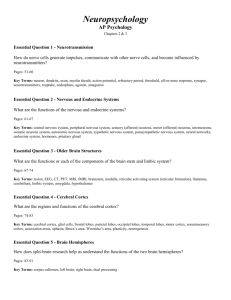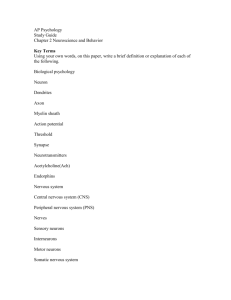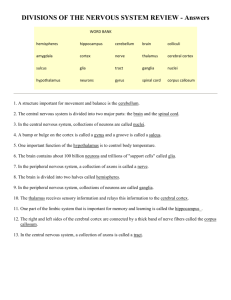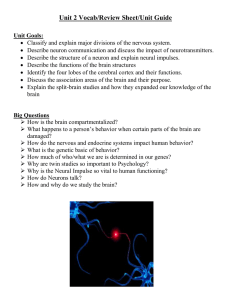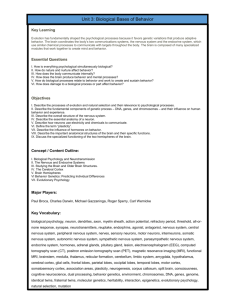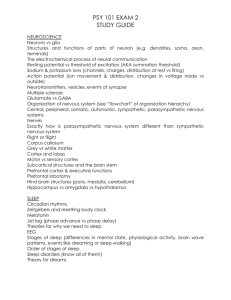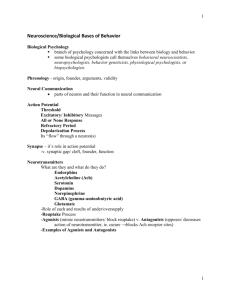Neuroscience and Behavior
advertisement
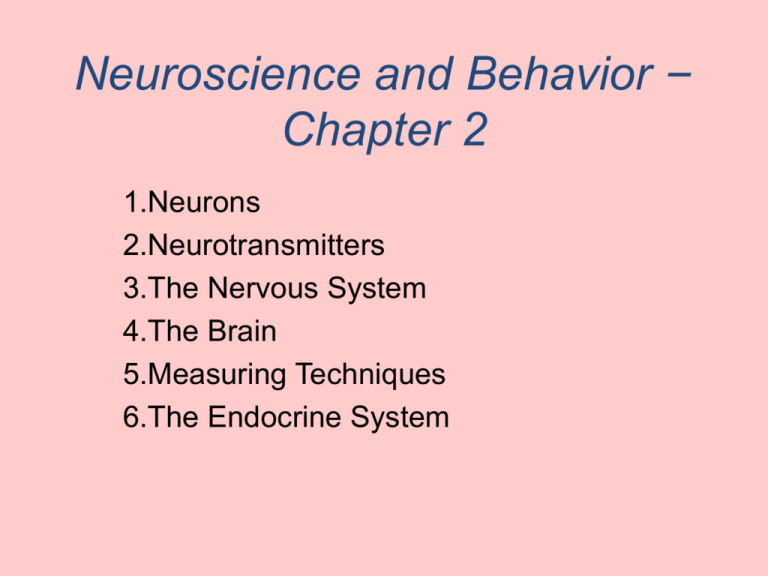
Neuroscience and Behavior – Chapter 2 1.Neurons 2.Neurotransmitters 3.The Nervous System 4.The Brain 5.Measuring Techniques 6.The Endocrine System Types of Neurons • Afferent neurons (Sensory), relay information from the senses to the brain and spinal cord. • Efferent neurons (motor), send information from the central nervous system to the glands and muscles, enabling the body to move. • Interneurons carry information between neurons in the Central Nervous System. • Parts of the Neuron – – – – – – Cell Body Dendrites Axon Myelin sheath Terminals Synapse • Glial cells Neuron Neurotransmitters • Acetylcholine excites skeletal muscles • Dopamine excites and inhibits learning, attention, movement, and reinforcement. • Norepinephrine affects eating habits, alertness, and wakefulness. Predominant in fear. • Epinephrine (also known as adrenaline) causes surges of energy. Predominant in anger. • Serotonin plays role in regulating mood, sleep, impulsivity, aggression and appetite. • Endorphins reduce pain and positively affect mood. Synapse • Structures at Synapse – – – – Axon Terminal Synaptic Vesicles Neurotransmitters Synaptic Cleft Nervous System • Central Nervous System – Brain – Spinal Cord • Peripheral Nervous System – Somatic Nervous System – Autonomic Nervous System • Sympathetic Nervous System • Parasympathetic Nervous System The Brainstem • Medulla controls automatic functions such as heartbeat, breathing, blood pressure, coughing, and swallowing • Reticular formation regulates attention and alertness • Pons plays a role in body movement and sleep and dreaming Structures of the Human Brain • • • • • • • • • Corpus Callosum Cerebrum Cerebral Cortex Substantia nigra Thalamus Hypothalamus Amygdala Hippocampus Cerebellum Click to see picture Lobes of the Brain • Frontal Lobe – Motor cortex Special Language Centers • Parietal Lobe – Somatosensory cortex • Occipital Lobes – Primary visual cortex • Temporal Lobes – Primary auditory cortex Special Language Centers • Broca’s Area • Wernicke’s Area Scanning Techniques • • • • CT Scan (computerized axial tomography) MRI (magnetic resonance imaging) PET Scan (positron-emission tomography) Functional MRI (fMRI) • Views or cuts – Axial – Sagittal – coronal Whole Brain Atlas Brain Waves • Beta wave – waves present while awake • Alpha wave – waves present in light sleep • Delta wave – waves present in deep sleep Endocrine System • • • • • Pituitary gland Thyroid gland Pancreas Adrenal glands Gonads

